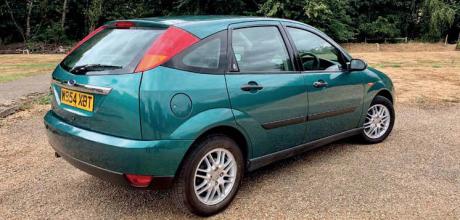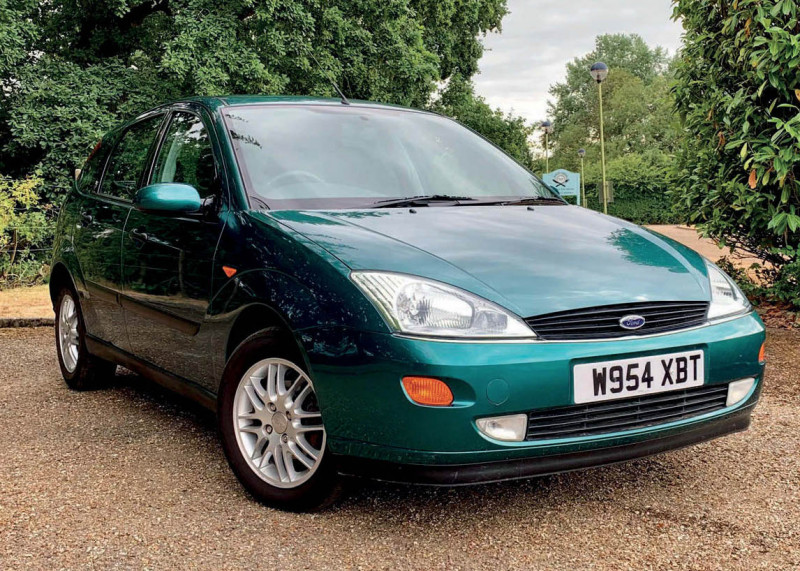Buying Guide Ford Focus Mk1

Sharp looks and excellent dynamics combined to make the original Ford Focus the family car of choice for enthusiasts. It still impresses today, as long as you bag a good ‘un…
A NEW EDGE
Words: Chris Randall
Photography: Jeff Ruggles
BUYING GUIDE: FORD FOCUS MK1
All you need to know when shopping for the critically acclaimed first-generation model
Eminently usable, fantastic to drive and cheap to buy, the first-generation Ford Focus is fast becoming a fine modern classic choice.

The Escort had been providing sensible family transport for some 30 years, but its replacement needed to move the game on. The Focus did just that, and then some.
Officially revealed at the 1998 Geneva Motor Show, the ‘New Edge’ styling courtesy of Claude Lobo and John Doughty meant the Focus looked sharper than any rival. But the real revelation was how it drove, with an engineering team led by the late Richard Parry-Jones imbuing the new model with a blend of ride, handling and responsiveness that was unmatched by anything else in the class. Motoring magazines of the day were rightly impressed, the Focus becoming the benchmark by which all other family cars were judged.
It’s still just as impressive today, and a good example feels very sweet to drive indeed. Being a Ford there was a wide choice of petrol and diesel engines, the former being 16-valve Zetec units ranging from a slightly underpowered 1.4-litre with 74bhp to the punchier 129bhp 2-litre. Properly sporting RS aside, those after more performance were offered the ST170 with 168bhp and uprated brakes and suspension. The 1.8-litre TDdi oilburner was frugal enough but made just 89bhp, and it was replaced in 2002 by a common-rail TDCi with a more useful 115bhp. That same year also saw a light facelift – indicators in the headlamps rather than front bumper being a giveaway. A plentiful choice of trim levels meant there was something for every preference and pocket, and by the time the second generation Focus arrived in 2004 the car had been a runaway success.
BODYWORK
Corrosion is a real issue, and with professional repairs unlikely to be economically viable we’d advise thorough checks. It can munch away at all the usual spots such as sills, door bottoms and wheelarches (especially at the rear) but you should also scrutinise the tailgate around the wiper and hinges. The front and rear screen surrounds, and the metalwork around the door mirrors are other potential rot-spots. Catch things early and DIY repairs might suffice but if it's more serious then finding a cleaner example is a better bet. As for the rest of the bodywork it’s a case of checking for the usual scuffs, scrapes and dents and ensuring that bumpers, light units and mirrors are undamaged. Headlight covers turn milky but they can be revived if the damage isn’t too severe. The huge number of cars sold in the UK means a good supply of second-hand parts, so concentrate on finding a fundamentally solid car rather than worrying about light cosmetic damage. Whether you prefer a hatchback, saloon or estate variant is a matter of personal taste, but the former was by far the most numerous and is easier to find today, as well as arguably making the best of the sharp styling. The saloon, meanwhile, is pretty rare in comparison.
ENGINE
Even the newest Mk 1 Focus is approaching 20 years old, so the important thing is ensuring that maintenance hasn’t become a distant memory. Petrol engines will cover high mileages if they aren’t neglected, so look for a record of regular oil and filter changes and a clever ‘Control Blade’ arrangement at the rear, and careful tuning provided the Focus with a delightful blend of ride and handling. It’s what makes one so compelling to drive today, so it’s well worth budgeting for a thorough overhaul to get that as-new feeling. If you can do the work yourself then replacing worn ball joints and bushes won’t break the bank, and the same applies to dampers and coil springs, although be prepared to tackle a few rusty bolts. New front struts are £60-80 with coil springs costing £30-35, and using good quality parts is best.
There’s nothing complicated about the brakes, so it’s a just a matter of checking for worn pads and discs, seized calipers and corroded pipework. Replacement parts are inexpensive, but if ABS is fitted then ensure the warning light illuminates and goes out correctly on start-up. Steering-wise, wear in the rack and associated joints and fluid leaks from the power-steering hydraulics are the things to watch for. It’s also worth listening out for the drone of worn wheel bearings (estate models seem more susceptible) but replacements are only around £35 each. Lastly, check for damaged and corroded alloys wheels along with worn and cheap tyres pointing to bargain-basement ownership.
TRIM AND ELECTRICS
While the cabin couldn’t really be considered plush (Ghia models aside, perhaps) buyers of a new Focus would have had few complaints when it came to build and material quality. Unsurprisingly, things may be rather less smart today so it’s going to be a case of avoiding examples where the interior has suffered from years of abuse. Damage to seat trim, carpets and plastics will be obvious, and if the bodywork and mechanicals are sound then rejuvenating things with second-hand trim is a reasonable proposition. It’s worth checking for water ingress, though; an incorrectly-fitted pollen filter can result in sodden foot-wells, while leaking rear light clusters damage the units themselves and let water into the boot area.
important is establishing that all the electrics work as they should, so check everything. Dicky central locking and electric windows can be caused by water getting into control units and broken wiring between door and body, while other specific items to concentrate on include failure of the windscreen and rear window heating elements; an inoperative internal boot release switch; and failure of the heater resistor. Air-conditioning that still blows cold is a bonus. The instrument cluster can fail, too, although specialist repair is less than £100, and a non-working speedometer can be caused by a failed gearbox speed sensor; the part is cheap but changing it is a fiddly job. It’s also worth ensuring that tailgate electrics work properly as the wiring between body and hatch can break. All of this stuff can be fixed but a car with multiple electrical woes will certainly test your patience.
VALUES
There are plenty of cars for sale privately and at independent traders, and examples with just a shred of MoT can be picked up for a few hundred pounds. Something in reasonable condition is £500-700, and spending twice that should bag a nice example with upwards of 100k miles on the clock. ST170s in smart condition are £1500-3000, but cooking models above £2000 are reaching top money and for that you should expect it to be in superb order with few miles and owners. Prices vary widely, so be prepared to shop around until you find a good one, and buy on condition rather than price.
THANKS TO: Anglia Car Auctions (angliacarauctions.co.uk) for the use of its Mk1 Focus.
OR MAYBE..?
Jeff Ruggles Editor
Vauxhall Astra G
The Mk4 Vauxhall Astra was never as stylish or revolutionary as the Focus, but it had a decent chassis, was safe and did most things very well. Even now they still make sense – they’re cheap to buy, cheap to run and easy to live with. Model choice is even wider than the Ford too, including the Bertone Coupe and Cabriolet, frugal diesels and the rapid turbo models.
Andrew Evanson
Lancaster Insurance Volkswagen Golf Mk4
Rivals may be more engaging to drive, but none can match the Mk4 Golf’s superb cabin and solid, understated image. It’s chunky styling was a neat design that still looks good, and as with the Focus, there’s a model to suit everyone from the humble 1.4-litre cars through to the powerful R32. Get hold of a good example while you still can.
INSURANCE COSTS
Quotation supplied by Lancaster Insurance 1999 Ford Focus 1.6 Zetec, value £1750 — £180.70 or £198.70 with Agreed Value Based on 45-year old, with a second vehicle. It’s garaged, covers 3000 miles a year and lives in an SP2 postcode. They have no claims or convictions, are a club member, and are employed as a marketing manager. Disclaimer: Policy benefits, features and discounts offered may vary between insurance schemes or cover selected and are subject to underwriting criteria. An additional charge may be payable. Subject to underwriting criteria. www.lancasterinsurance.co.uk 01480 809176
FOCUS RS
Going on sale in 2002, the RS became an instant classic thanks to limited numbers and an enticing specification. Just 4501 were made with just over 2000 coming to the UK, and all were painted Imperial Blue. They certainly looked the part with plenty of RS-specific features both inside and out, while power came from a turbocharged 2.0-litre engine that made 212bhp — enough for 0-60 in 5.9 seconds and 143mph. Despite the Quaife limited-slip diff things could still get a bit unruly, though. Prices for nice ones start in the midteens, but rust is an issue and some of the unique parts are scarce.
The Mk1 Focus became a new benchmark within its sector for vehicle dynamics.
EV SAYS… Andrew Evanson Senior Operations Manager at Lancaster Insurance Services, says: “The Focus was a game-changer and is sure to be highly prized in future.”
SPECIFICATIONS
- MODEL 1.6 / 1.8 / 2.0 / ST170 / TDCi 115
- ENGINE 1596cc 1796cc 1989cc 1989cc 1753cc
- GEARBOX 5-spd man 5-spd man 5-spd man 6-spd man 5-spd man
- POWER 100bhp 113bhp 128bhp 171bhp 113bhp
- TOP SPEED 115mph 123mph 125mph 137mph 122mph
- 0-60MPH 11.2secs 10.3secs 9.3secs 7.5secs 10.7secs
- ECONOMY 40mpg 37mpg 32mpg 32mpg 52mpg
- LENGTH 4150mm 4150mm 4150mm 4150mm 4150mm
- WIDTH 1700mm 1700mm 1700mm 1700m 1700mm
- WEIGHT 1077kg 1129kg 1156kg 1245kg 1288kg
Petrol engines varied in size from 1.4- to 2-litres, with diesels also available. The interior was praised for its build quality and still looks modern today. The hatchback was by far the most popular variant, with saloons particularly rare.

